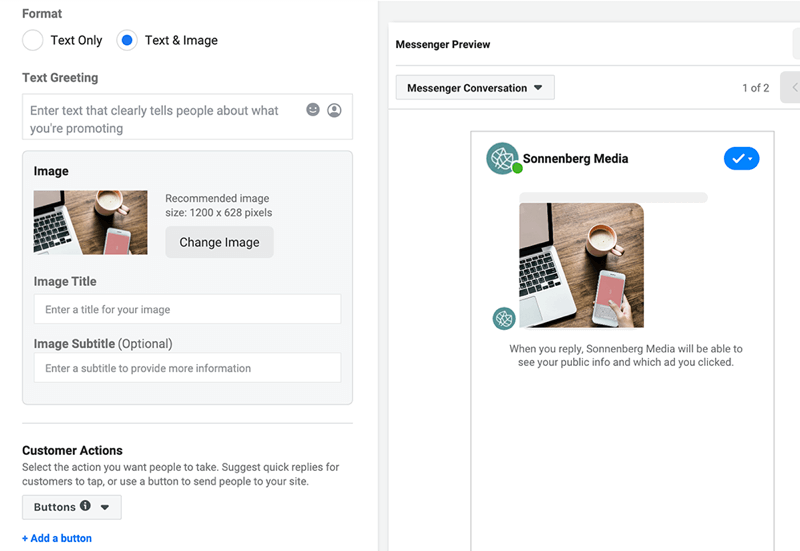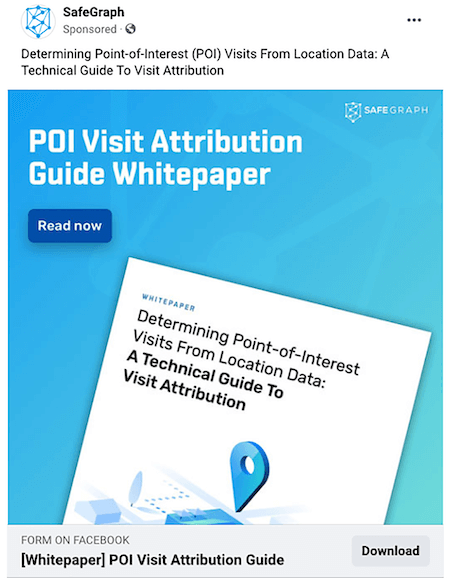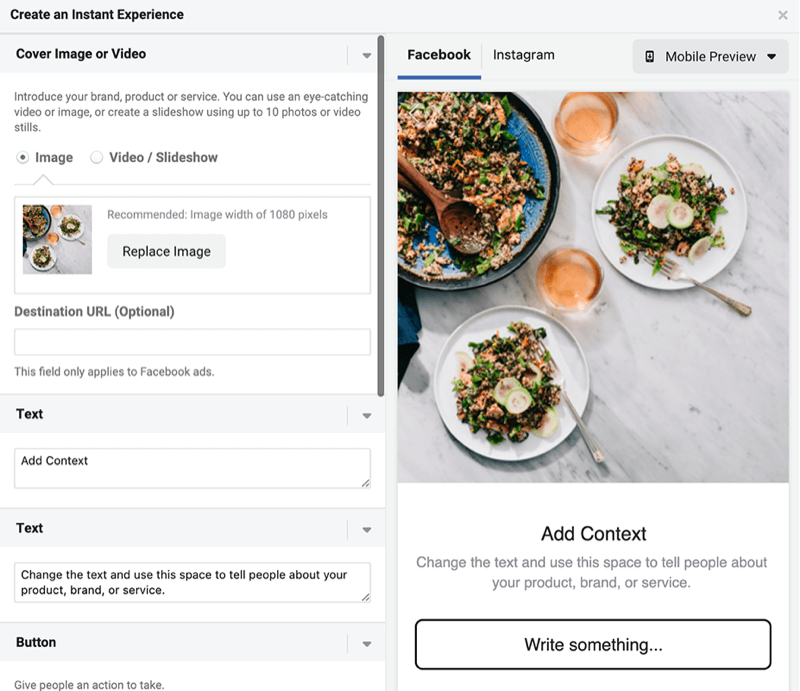11 Facebook Ads Ideas to Improve Your Results
Are your Facebook ads failing to deliver? Have you considered different types of ads on Facebook?
In this article, you’ll learn how to choose the best Facebook ad for your business goals and why your choice matters in the long-term. You’ll also find effective ad examples to inspire your next campaign.

Why Choosing the Right Facebook Ad Type Matters
Perhaps you want to introduce your brand to a new market. Or maybe you need to get more prospects into your sales funnel. Either way, it’s essential to choose a Facebook ad type that fits with the business goal you want to achieve.
If your team has limited resources or a tight campaign budget, you might feel pressure to create the simplest ad possible or use the assets you already have. But what if there’s a more effective option?
For example, if your creative assets are limited to a few lifestyle photos, you might default to publishing a basic image ad. Although that approach can save time and money up front, it won’t necessarily generate the best results in the end.
Instead, when you’re deliberate about choosing a Facebook ad type that complements your business goals, you can focus on what matters most: the outcome your team wants to achieve. For example, this @DashHudsonForBrands Facebook carousel ad uses a series of graphics to drive interest and consideration. Each creative features unique benefits and has a clickable CTA to encourage action.

The Facebook Ad Type You Choose Guides the Facebook Ads Algorithm
When you launch a Facebook ad campaign, naturally you want to get the best possible results given your budget, offer, and target audience. The Facebook ads platform is designed to help you do just that—but you have to steer the algorithm in the right direction.
When determining whether to show your ad to a given user, the Facebook ads algorithm takes several factors into account. It considers:
- Your bidding strategy, which could be cost-, value-, or return-based
- The quality of your ad, based on feedback from users who have seen it
- Estimated action rates, which indicate how likely a person is to act on your ad
If you create a video ad, for example, the Facebook ads algorithm will trend toward delivering it to people who typically watch or engage with videos. That sounds pretty ideal if your goal is driving consideration via video views, like this @ConnecteamSoftware video ad.

What if your business goal is something entirely different, such as generating revenue via eCommerce purchases? Another ad type can deliver much better results because it’s geared toward an audience that’s primed to browse and buy.
The Facebook Ad Type You Choose Impacts the Buyer’s Journey
Even if people in your target audience have a lot of characteristics or interests in common, they might not be at the same stage of the buyer’s journey. In other words, some people might be starting to research solutions and may need a lot more convincing. In contrast, others may be ready to give you their money.
When you use the Facebook ad type that fits with your business goal, you can show the most effective ad to the people in the right stage of the buyer’s journey:
- Awareness: New prospects who are just beginning to learn about your brand, products, and services as they start to figure out what they need
- Consideration: Middle-of-funnel prospects who are seriously researching and comparing solutions as they actively gather information
- Conversion: Customers who are ready to make a choice, sign up for a trial, or purchase a solution
How to Match Your Business Goal With the Right Facebook Ad Type
Facebook has about a dozen ad types you can use in your campaigns but some are available for select campaign objectives only. Each has unique features and offers valuable opportunities to connect with a specific target audience.
#1: Image Ads
Typically the simplest in appearance and the quickest to produce, this Facebook ad type features a single image, which can be either a photo or graphic. Your image can also include text to reinforce your message or share additional information.
Although Facebook states that it’s best to use text overlays on 20% or less of the image, this @brightbackio ad demonstrates how effective text can be in an image ad. The statistics jump out from the image, and the red, yellow, and green color scheme creates an eye-catching stoplight effect.

The Facebook ads platform allows image ads for almost every campaign objective. However, this ad type often works best when you plan to target people in the awareness or consideration stage. Image ads are ideal for goals like:
- Increasing brand awareness or keeping your business top-of-mind with customers
- Launching a new product or branching out into a new market
- Getting people’s attention and encouraging them to click through to your site
#2: Slideshow Ads
Slightly more complex than image ads, Facebook slideshow ads include multiple creatives, as well as optional audio. With a slideshow ad, you can essentially animate still images, which can draw more attention to your campaign.
There’s no need to acquire animation software, as you can create this type of ad in the Facebook ads platform using branded or stock images.

Because slideshow ads can express more involved messages, they tend to be ideal when targeting people in the awareness or consideration stage. They’re great for goals like:
- Sharing your company’s mission or story with interested customers
- Showing prospects how to use your product or service
- Delivering a video-like creative on a significantly smaller budget
#3: Video Ads
More than image and slideshow ads, Facebook video ads have the power to convey complicated information and tell intricate stories. If you really want to capture your audience’s attention and get them interested in your business, product, or service, a video ad is a smart solution.
This @getoribi video ad explains the benefits of the brand’s analytics platform, using puppets to add an element of entertainment. Because it’s one in a series of consideration-focused video ads, it allows the brand to fully leverage the storytelling capabilities of video.

Although you can pair a video ad with nearly every Facebook campaign objective, this type often works best when you use a consideration goal. If you pair it with a video views objective, for example, you can accomplish goals like:
- Educating prospects about your brand, product, or service
- Weaving engaging stories that resonate with your audience
- Building a remarketing audience based on people who watched your video
#4: Stories Ads
With an estimated 500 million users, Facebook Stories offers tons of opportunities to connect with prospects in more creative and engaging ways. In fact, there’s a good chance that your ad will automatically appear in Stories if your campaign uses automated placements.

You can easily take additional steps to align your Stories ads with your business goal. To get more value from this placement, you can add text overlays to share more information or use vertical images that are easier to view in Stories. With Facebook Stories ads, you can achieve goals like:
- Making a more personal connection with your audience
- Building trust by creating authentic content
- Getting people to click through to your site via the swipe-up feature
#5: Messenger Ads
Your Facebook ad doesn’t have to be a one-way avenue for communication. With Facebook Messenger ads, you can start conversations with the app’s 1.3 billion users.

Messenger ads are available with the messages campaign objective, which targets middle-of-funnel prospects in the consideration stage of the buyer’s journey. With these sponsored inbox messages, you can:
- Gather information about prospects such as preferences or objections.
- Direct people to use a specific feature within your Messenger bot.
- Cultivate relationships with people who have already engaged with your Messenger bot.
#6: Lead Ads
Messenger ads aren’t the only avenue for learning about your target audience. With Facebook lead ads, you create forms that prospects can fill out to access your offer, which might be a downloadable asset or a free trial.
In the ad below, @SafeGraph encourages prospects to download a technical guide. In exchange, the brand collects prospects’ contact details.

One of the major benefits of lead ads is that they require an exchange: Prospects provide their information and you deliver a high-value offer. As such, this ad type is best when targeting people who are at the bottom of the funnel in the consideration or conversion stages of the buyer’s journey. With lead ads, you can accomplish goals like:
- Collecting contact information so you can email or call prospects directly
- Gathering data about prospects’ job titles, needs, and interests
- Providing a valuable asset that helps you build trust and credibility
#7: Carousel Ads
A slideshow ad isn’t your only choice for telling a story with multiple images. Facebook carousel ads have interactive elements and allow users to click through up to 10 images or videos. Each creative gets its own headline and CTA button, giving your ad plenty of opportunities to prompt action.
If you upload a catalog, you can even show prices and encourage people to click through to view individual items. In the ad below, @octaneai uses a carousel to showcase the benefits of the brand’s shopping personalization platform. Each creative features a Book Now CTA to drive conversions.

Carousel ads can accomplish goals like:
- Generating leads, driving revenue, and encouraging other conversions
- Educating prospects by showing multiple products or a range of features
- Explaining how to do something or showing how something works
#8: Collection Ads
Although carousel ads can certainly showcase your product line, Facebook collection ads take the concept a step further by letting you curate a compelling experience for potential customers. Collection ads feature a hero image or video above a grid with smaller images, and you can use Facebook’s templates to drive discovery or conversions.
With a collection ad, you can achieve goals like:
- Creating an immersive experience that delights your prospects
- Increasing conversions and customer acquisitions
- Adding an instant experience that drives further interest
#9: Instant Experience Ads
When users click on your collection ad, they automatically go to your instant experience, which is an immersive mobile format. You can also add instant experiences to several other campaign objectives.

With an instant experience, your team can:
- Create an engaging, user-friendly experience that highlights your products.
- Tell a more comprehensive brand story by linking several instant experiences.
- Retarget people who engaged with a certain instant experience.
#10: Playable App Ads
If you have an app to promote, you can do much more than just show prospects a few screenshots or a video of the in-app experience. With Facebook ads, you can also create a playable creative. This ad type is ideal for prospects in the conversion stage because it’s geared toward getting people to install and use the app.
With a playable app ad, you can:
- Capture attention via an interactive and immersive game preview.
- Give customers a chance to try out your app or game before installing.
- Target engaged people who could end up being loyal fans or big spenders.
#11: Dynamic Ads
If you have a product catalog to advertise, your team can take advantage of Facebook dynamic ads. Instead of requiring a separate ad for every product in your catalog, dynamic ads automatically determine which product to show to each person. Although you can certainly show dynamic ads to people throughout the buyer’s journey, they’re particularly effective for prospects in the conversion stage.

In fact, if you have the Facebook pixel installed on your website, you can remarket to visitors. You can even show them the exact products they already viewed to give them another chance to make a purchase. Alternatively, you can show them related products to generate additional interest.
With dynamic ads, you can achieve goals like:
- Remarketing to people who have already shown strong interest in your brand
- Displaying the most popular or relevant products in your catalog
- Automatically displaying the products most likely to encourage action
How to Create a Goal-Focused Facebook Ads Funnel: 3 Easy-to-Follow Examples
In some cases, you may opt to focus all of your team’s energy on one simple business goal. In other cases, you may need to build up to a bigger objective step by step or work toward multiple goals simultaneously.
By creating a simple Facebook ads funnel, you can incorporate several complementary ad types and campaign objectives. With a funnel, you can also guide prospects through each stage of the buyer’s journey and continually bring new people into your sales pipeline.
Here’s how your Facebook ads funnel might look:
- Awareness: Create a reach campaign with image or slideshow ads, using demographics and interests to create a target audience.
- Consideration: Design a web traffic campaign with slideshow ads and follow it up with a lead generation campaign using a lead form ad.
- Conversion: Launch a conversion campaign using a dynamic carousel ad that remarkets to website visitors and shows them the products they’ve viewed.
Conclusion
Now that you know how to align Facebook ad types with business goals, you can create more effective campaigns. By choosing an ad type that complements your brand’s goal, you can generate better results and improve your return on ad spend.
Shared from original article posted by Anna Sonnenberg on Social Media Examiner https://www.socialmediaexaminer.com/11-facebook-ads-ideas-to-improve-your-results/
